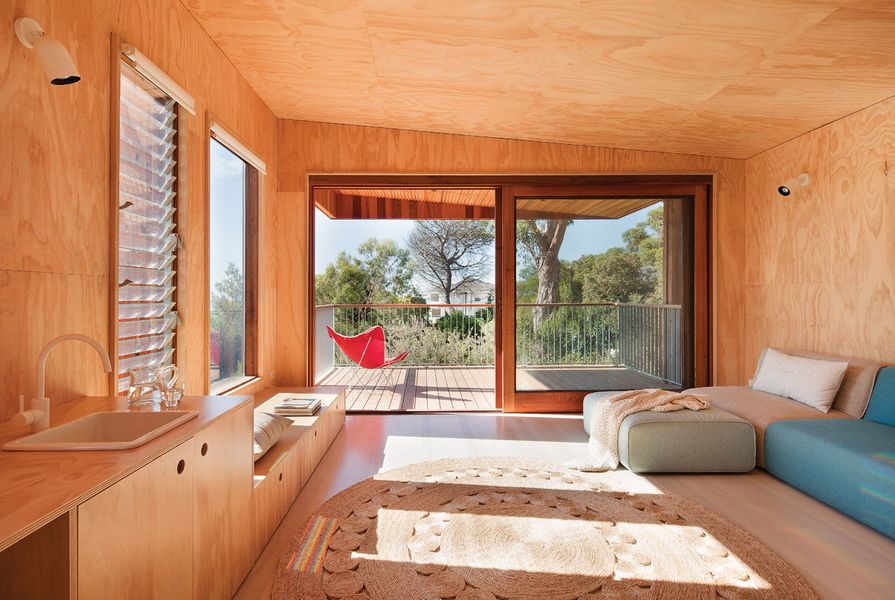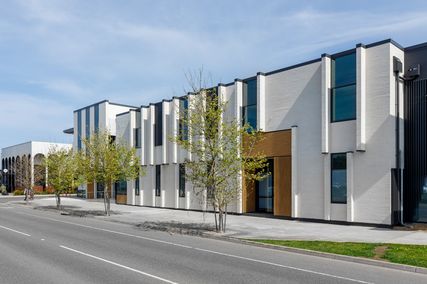Despite its slightly ambiguous geographical status – no longer a seaside village, not yet an outer suburb – Mornington still feels like a place to go when you want to escape the city. The breeze blows fresh off the bay; the kids playing in the park at the end of the main street are just as interested in climbing the massive Moreton Bay fig as they are the monkey bars; and on a good day, the water at Mothers Beach is crystal clear, and tiny fish flash silver as they dart to and fro. Melbourne’s southern conurbation grows apace, but along the beach at Mornington, nature is still in the ascendancy.
Nowhere is this more apparent than in the bushy hills that rise above the sand to the east of the town centre. A diverse collection of houses – permanent residences and weekend getaways – nestles amongst remnant bushland. One of these, a Merchant Builders home, has served the same family as a beach house and home away from home since it was constructed in 1979. With a third generation now reaching adulthood, and bringing an extended family of friends and partners, the decision was made to extend.
The brief given to Melbourne architect Clare Cousins called for a new main bedroom wing, living space, ensuite, study, kitchenette and deck, and access to views of the bay to the west. A couple of major constraints had a significant influence on the final design – the positioning of the original house to the rear of the block meant that the new wing would be appended to its front; and a covenant over double-storey construction in the area demanded that the lower level be allocated to parking or storage. But as is so often the case with great residential architecture, these constraints have been used as inspiration for something completely new – in this case, a self-contained, timber-clad treehouse that elevates its owners’ daily lives both literally and metaphorically.
Timber buttresses support the cypress and cedar-clad extension.
Image: Shannon McGrath
The new wing is connected to the original via a translucent fibreglass stairway adjacent to the main entry. It’s a rudimentary space, deliberately so, which marks the transition from main house to new wing aesthetically – raw pine studs with expressed fixings establish a naturalistic, minimalist feel – and experientially – there’s no airconditioning or heating to mitigate the external weather conditions.
At the top of the stairs, the architects have packed a lot into forty-eight square metres. At one end, a bedroom and ensuite; at the other, an open deck that looks out to the bush and the bay; and in the middle, an open living area with a fireplace, study space, sink and concealed bar fridge. The bedroom is delineated by a rise in floor level of a few steps that echoes the topography of the site, and can be closed off from the main space with a sliding door. Programmatically, it’s a smart studio apartment, but the way the design has been executed, in this very particular context, makes it something else altogether.
The 48-square-metre space is programmed like a clever studio apartment.
Image: Shannon McGrath
The interior is clad almost exclusively in hoop pine ply, tacked in place and left unfinished. Combined with Tasmanian oak floors, the material has a cocooning effect and yet, with a bank of windows along the western wall and sliding glass doors at the northern end, the space also feels open and airy. Architects (and clients) so often plump for white walls and ceilings for light and bright interiors, but here we not only see that it’s not always necessary – the Australian sun does a pretty good job of “bright” without any assistance – but that the ambience created by light bouncing off raw timber is more natural, more even, and a whole lot more relaxing.
View from the covered deck out to the bay.
Image: Shannon McGrath
With windows opened up for cross-ventilation and a cooling sea breeze in full effect, the idea of the extension as a treehouse shifts from analogy to reality. The view through the windows, and from the undercover deck, takes in a classic Australian bush scene of swaying eucalypts and, seen through their foliage, the grey-blue waters of Port Phillip Bay beyond.
This feeling of intimate contact with the natural world – the emphasis on the landscape and the experience of occupying the new wing – is instantly calming. Even viewed from the outside, the new structure speaks of nature, with cypress structural elements and Western red cedar cladding right at home in the bushy context. Just as importantly, a comfortable fit has been achieved with the original home. The chimney in the new wing, constructed from recycled brick and painted white to match the old house, is the only explicit material link between old and new. However, they’re linked at a fundamental level by an overarching aesthetic of simplicity and informality, and together create a place for relaxation and communion with the natural landscape that will be appreciated by the next generation of occupants, and perhaps a few more after that.
Products and materials
- Roofing
- Lysaght Trimdek in Colorbond ‘Windspray’.
- External walls
- Tilling Timber Western red cedar V-joint cladding; Laminated Timber Supplies cypress Durabeam structural timber.
- Internal walls
- Plywood cladding.
- Windows and doors
- Trend Windows and Doors Western red cedar windows and doors.
- Flooring
- Radial Timber Sales silvertop ash timber decking; Tasmanian oak flooring limed with Feast Watson liming solution.
- Lighting
- Masson For Light Comet wall light.
- Kitchen
- Fisher and Paykel bar fridge integrated with plywood joinery; Reece Caroma Lab sink; Astra Walker mixer.
- Bathroom
- Reece Scala mixer; Pozzi-Ginori wall basin; plywood joinery; Fibonacci Stone floor tiles, honed; Classic Ceramics wall tiles; Sussex Pol shower head.
- Heating and cooling
- Jetmaster Heat and Glo gas fire unit.
- Other
- Jardan Milo sofa; custom-made plywood bed.
Credits
- Project
- Beach House Mornington
- Architect
- Clare Cousins Architects
Melbourne, Vic, Australia
- Project Team
- Clare Cousins, Tara Ward, Jessie Fowler
- Consultants
-
Builder
Greg Scott Constructions
Engineer Co-Struct
- Site Details
-
Location
Mornington,
Melbourne,
Vic,
Australia
Site area 1308 m2
Building area 301 m2
- Project Details
-
Status
Built
Design, documentation 7 months
Construction 6 months
Category Residential
Type Alts and adds, New houses
Source

Project
Published online: 17 Feb 2014
Words:
Mark Scruby
Images:
Shannon McGrath
Issue
Houses, October 2013































